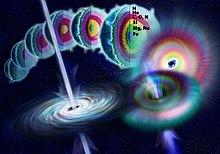GRB 970228
Since 1993, physicists had predicted GRBs to be followed by a lower-energy afterglow (in wavelengths such as radio waves, x-rays, and even visible light), but until this event, GRBs had only been observed in highly luminous bursts of high-energy gamma rays (the most energetic form of electromagnetic radiation); this resulted in large positional uncertainties which left their nature very unclear.
A gamma-ray burst (GRB) is a highly luminous flash of gamma rays, the most energetic form of electromagnetic radiation.
[5] GRB 970228[2] was detected on 28 February 1997 at 02:58 UTC by the Gamma-Ray Burst Monitor (GRBM) and one of the Wide Field Cameras (WFCs) on board BeppoSAX,[6][7] an Italian–Dutch satellite originally designed to study X-rays.
One possible explanation is that multiple peaks are formed when the source of the gamma-ray burst undergoes precession.
[11] About one and nine days later, optical images of the error box were taken with the William Herschel Telescope on La Palma; comparison of the images revealed a fading point source located at a right ascension of 05h 01m 46.7s and a declination of +11° 46′ 53.0″, providing the first arcsecond-accuracy localization of any Gamma-ray burst.
[13] The Narrow Field Instruments on board BeppoSAX began making observations of the GRB 970228's position within eight hours of its detection.
Deeper follow-up observations using the New Technology Telescope showed that the afterglow coincided with a distant, small galaxy: the first evidence of the extragalactic, cosmological nature of Gamma-ray bursts.
[15][16] After the gamma-ray bursts itself had faded away, very deep observations taken with the Keck telescopes showed the underlying galaxy to have a redshift of 0.695.
[18] Daniel Reichart of the University of Chicago and Titus Galama of the University of Amsterdam independently analyzed GRB 970228's optical light curve, both concluding that the host object may have undergone a supernova explosion several weeks before the gamma-ray burst occurred.
[25] However, supernova-like features only become apparent in the weeks following a burst, leaving the possibility that very early luminosity variations could be explained by dust echoes.
